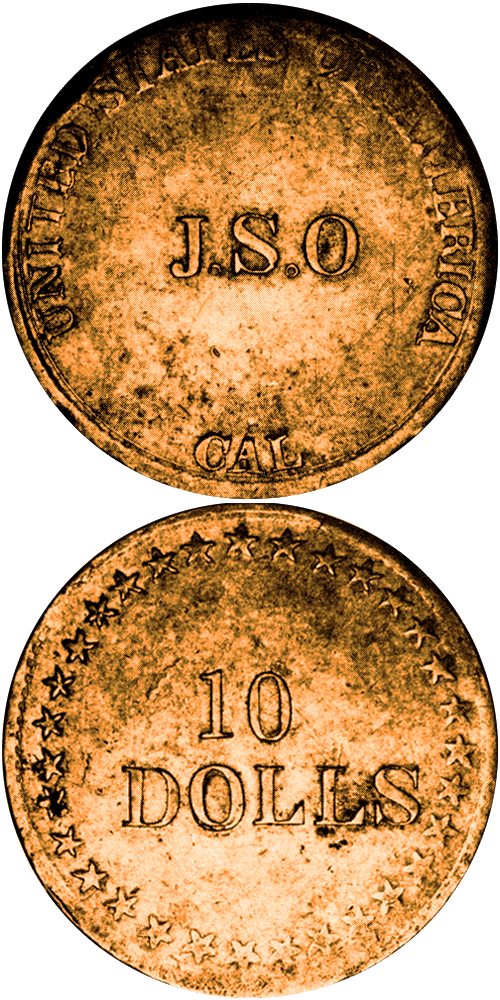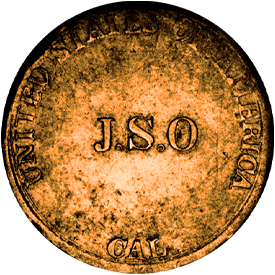The firm of J. S. Ormsby & Co. was prominent among the early issuers of private California gold coins. The principals in the firm were Dr. J. S. Ormsby, who is believed to have come from Pennsylvania, and Maj. William M. Ormsby, who was killed in 1 860 in a battle with the Indians at Winnemucca, Nevada. Ormsby County, Nevada honors his memory.
Desiring to be closer to the gold fields than San Francisco, the company opened its doors on K Street in Sacramento early in 1849. Apparently they conducted an extensive assaying, smelting, refining, and coining business. Although specimens of the Ormsby coinage, made in $5 and $10 denominations, were once plentiful, they are great rarities today. The pieces, which are not dated and use the initials JSO as part of the design, were struck by a sledgehammer rather than a coining press. The principal workman at the enterprise was Dr. William W. Light, a dentist who earlier came from Bethel, Claremont County, Ohio. Following an education in dentistry and medicine he departed on January 31, 1849 for California reaching there in August. In the History of Sacramento County Winfield J. Davis noted:
He found employment almost immediately with the Ormsbys, who had set up a mint and were coining gold. Not knowing how to do the annealing, however, they were making bad work of it and were glad to employ the doctor at $50 a day to superintend the work, but he shortly after quit that situation and went mining.
According to an article in the New York Herald, May 11, 1849 the Ormsbys came to California as members of a party which was at the jumping-off spot at St. Joseph, Missouri, at that time. Listed were Dr .
J. S. Ormsby and L. P. Ormsby; Maj. William Ormsby and J. K. Trumbull of Kentucky; and several others from Westmoreland, Pennsylvania. The group was provided with four wagons, six mules for each, and necessary provisions.
Adams quotes an article which appeared in the San Jose Pioneer issue of May 5, 1877, written by a California pioneer. Included is some interesting information concerning Ormsby and related activities:
In the flush days of '49 gold was so plentiful in San Francisco, Sacramento, and other towns, that its value was not readily appreciated. There was plenty of gold, but no coin. This was the basis of one of the first speculations of the country.
In the general rush to California, consequent upon the discovery of gold at Sutter's sawmill, among other machinery brought here was a quantity for the purpose of coining the precious metals. Almost every company crossing the plains or rounding the Horn brought with them ample machinery for this purpose, and several well-known institutions of this kind did an extensive business in San Francisco.
The singularly-shaped block of granite found buried in the sand at the time of the excavation for the foundation of the California Market, some years since, which is still to be seen at the junction of Sumner Street with the market nearest Montgomery Street, and which excited so much speculation at the time of its discovery, was undoubtedly intended for this purpose, and portions of iron-work designed for similar use lay within a few years past scattered about various portions of Sacramento.
A private mint was established in Sacramento in 1849, and continued through the following year, by J. S. Ormsby & Co.
The company consisted of Maj. Ormsby, who was killed by the Indians in the Winnemucca War, famous in the early annals of the State of Nevada, and his brother, Dr. Ormsby, who some years after represented the County of Sonoma in the California Assembly.
This establishment, which was located on K Street just below the site of the Golden Eagle, did an extensive business, the miners bringing dust to be coined forming a line and awaiting their regular turn. The gold was melted here, and without alloy, as it came from the mine, cast into bars, rolled into strips, the rollers used for this purpose being still in the possession of Dr. Light, a leading dental surgeon of Sacramento, who was the chief operator of the establishment at a salary of $50 per diem.
Coins of the denominations of $5 and $10 were issued, stamped with the name of the proprietors, who received a royalty of $4 on every $20 coined. It is the opinion of the gentleman named as the chief operator of the concern, who was the melter and aided by an assistant rolled out the bullion and struck the dies with a sledge hammer, that the crucibles used in melting the dust, and which have long been buried by the filling of the street, contain a large amount of gold, so wasteful was the operation and so plentiful the precious metals, in those days which constituted the flush time in California.
Today only one specimen of the $5 denomination is known, a coin formerly owned by Jacob B. Moore, Jr., since its coinage in 1849. Moore was employed by his father, the postmaster of San Francisco, as an assistant during that year.
Ten-dollar pieces are of great rarity, and only a few are known to exist. Near the time of issue several pieces reached the Philadelphia Mint, where the assay of one showed a fineness of .842 and an intrinsic value of $9.37.
Designs of the two Ormsby denominations are very plain. Undated, each bears the initials JSO, the denomination, UNITED STATES OF AMERICA, and a circle of stars. The $5 piece has the notation CAL. Devoid of adornment, the Ormsby coins were strictly functional. At the time they served a good purpose, as the line of miners bringing dust to be coined, as mentioned in the quoted article, indicates.







